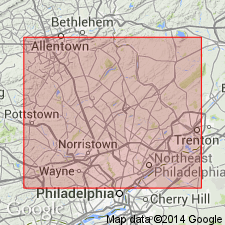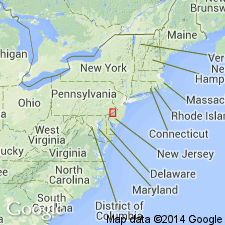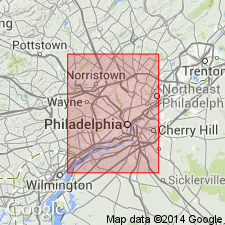
- Usage in publication:
-
- Gwynedd shales
- Modifications:
-
- Named
- Dominant lithology:
-
- Shale
- AAPG geologic province:
-
- Newark basin
Summary:
Hard dark red, green, gray, and black shales overlying the Norristown shales and underlying the Lansdale shales are here named the Gwynedd shales of the New Red series. They form prominent ridges from Point Pleasant and from Lower Wakefield Township on the Delaware River to Chalfont, then to the Gwynedd and Phoenixville tunnels near the Schuylkill River. Thickness is 3,500 ft. Fossils indicate a Triassic or Jurassic age.
Source: GNU records (USGS DDS-6; Reston GNULEX).

- Usage in publication:
-
- Gwynedd shales*
- Modifications:
-
- Overview
- AAPG geologic province:
-
- Newark basin
Summary:
The Triassic series in the Philadelphia district is represented by the Norristown, Gwynedd, Lansdale, Perkasie, and Pottstown shales. It is footnoted that N.H. Darton divides the Triassic into the Stockton formation, corresponding to the Norristown, the Lockatong formation, corresponding to the Gwynedd, and the Brunswick shale, corresponding to the Lansdale, Perkasie, and Pottstown.
Source: GNU records (USGS DDS-6; Reston GNULEX).

- Usage in publication:
-
- Gwynedd†
- Modifications:
-
- Abandoned
- AAPG geologic province:
-
- Newark basin
Summary:
The classification of the Newark group established in NJ is here adopted by the USGS in PA. It comprises the Stockton, Lockatong, and Brunswick formations, approximately equivalent to the Norristown, Gwynedd, and Lansdale shales, respectively, which have not been found acceptable because of their indefinite application.
Source: GNU records (USGS DDS-6; Reston GNULEX).
For more information, please contact Nancy Stamm, Geologic Names Committee Secretary.
Asterisk (*) indicates published by U.S. Geological Survey authors.
"No current usage" (†) implies that a name has been abandoned or has fallen into disuse. Former usage and, if known, replacement name given in parentheses ( ).
Slash (/) indicates name conflicts with nomenclatural guidelines (CSN, 1933; ACSN, 1961, 1970; NACSN, 1983, 2005, 2021). May be explained within brackets ([ ]).

